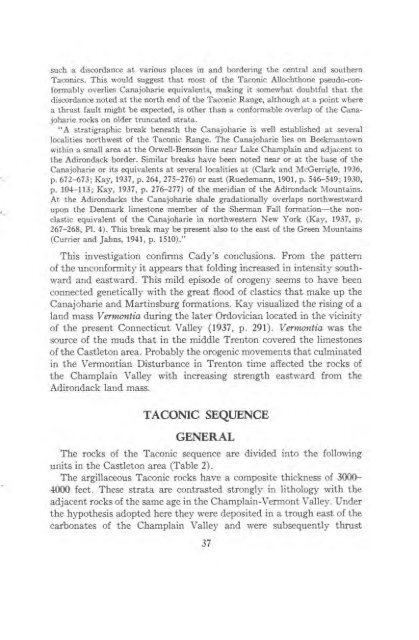STRATIGRAPHY AND STRUCTURE CASTLETON AREA VERMONT
STRATIGRAPHY AND STRUCTURE CASTLETON AREA VERMONT
STRATIGRAPHY AND STRUCTURE CASTLETON AREA VERMONT
Create successful ePaper yourself
Turn your PDF publications into a flip-book with our unique Google optimized e-Paper software.
such a discordance at various places in and bordering the central and southern<br />
Taconics. This would suggest that most of the Taconic Allochthone pseudo-conformably<br />
overlies Canajoharie equivalents, making it somewhat doubtful that the<br />
discordance noted at the north end of the Taconic Range, although at a point where<br />
a thrust fault might be expected, is other than a conformable overlap of the Canajoharie<br />
rocks on older truncated strata.<br />
"A stratigraphic break beneath the Canajoharie is well established at several<br />
localities northwest of the Taconic Range. The Canajoharie lies on Beekmantown<br />
within a small area at the Orwell-Benson line near Lake Champlain and adjacent to<br />
the Adirondack border. Similar breaks have been noted near or at the base of the<br />
Canajoharie or its equivalents at several localities at (Clark and McGerrigle, 1936,<br />
p. 672-673; Kay, 1937, p. 264, 275-276) or east (Ruedemann, 1901, p. 546-549; 1930,<br />
p. 104-113; Kay, 1937, p. 276-277) of the meridian of the Adirondack Mountains.<br />
At the Adirondacks the Canajoharie shale gradationally overlaps northwestward<br />
upon the Denmark limestone member of the Sherman Fall formation—the nonclastic<br />
equivalent of the Canajoharie in northwestern New York (Kay, 1937, p.<br />
267-268, P1. 4). This break may be present also to the east of the Green Mountains<br />
(Currier and Jahns, 1941, p. 1510)."<br />
This investigation confirms Cady's conclusions. From the pattern<br />
of the unconformity it appears that folding increased in intensity southward<br />
and eastward. This mild episode of orogeny seems to have been<br />
connected genetically with the great flood of clastics that make up the<br />
Canajoharie and Martinsburg formations. Kay visualized the rising of a<br />
land mass Vermontia during the later Ordovician located in the vicinity<br />
of the present Connecticut Valley (1937, p. 291). Vermontia was the<br />
source of the muds that in the middle Trenton covered the limestones<br />
of the Castleton area. Probably the orogenic movements that culminated<br />
in the Vermontian Disturbance in Trenton time affected the rocks of<br />
the Champlain Valley with increasing strength eastward from the<br />
Adirondack land mass.<br />
TACOMC SEQUENCE<br />
GENERAL<br />
The rocks of the Taconic sequence are divided into the following<br />
units in the Castleton area (Table 2).<br />
The argillaceous Taconic rocks have a composite thickness of 3000-<br />
4000 feet. These strata are contrasted strongly in lithology with the<br />
adjacent rocks of the same age in the Champlain-Vermont Valley. Under<br />
the hypothesis adopted here they were deposited in a trough east of the<br />
carbonates of the Champlain Valley and were subsequently thrust<br />
37













